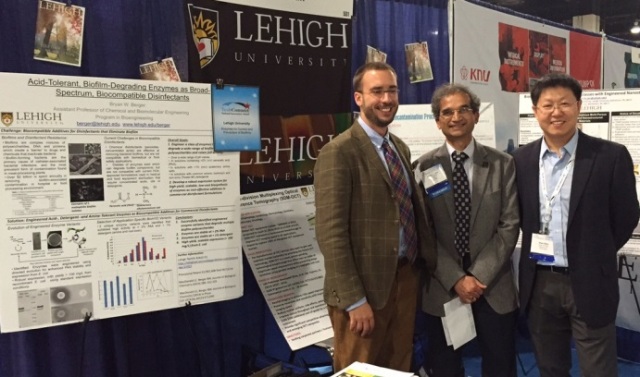Lehigh scientists and engineers won three National Innovation Awards recently at the TechConnect 2015 World Innovation Conference and National Innovation Showcase held in Washington, D.C.
The awards were for a nanoscale device that captures tumor cells in the blood, a bioengineered enzyme that scrubs microbial biofilms, and a safe, efficient chemical reagent that is stable at room temperature.
Lehigh’s TechConnect initiative was led by the Office of Technology Transfer (OTT) which manages, protects and licenses intellectual property (IP) developed at Lehigh. Yatin Karpe, associate director of the OTT, spearheaded the Lehigh effort and is pursuing IP protection and commercialization for the innovations.
The P.C. Rossin College of Engineering and Applied Science, led by former interim Dean Daniel Lopresti, and the Office of Economic Engagement, led by assistant vice president Cameron McCoy, supported Lehigh’s third-straight appearance at the annual conference.
The three National Innovation Awards were chosen through an industry review of the top 20 percent of annually submitted technologies and based on the potential positive impact the technology would have on industry.
This is the third year in a row that Lehigh has won Innovation Awards. No institution received more than three in 2015.
Lehigh’s National Innovation Awardees were:
• Yaling Liu, assistant professor of mechanical engineering and mechanics and a member of the bioengineering program, has developed a tiny device that can capture tumor cells circulating in the blood and can potentially indicate disease type, as well as genetic and protein markers that may provide potential treatment options.
• Bryan Berger, assistant professor of chemical and biomolecular engineering, hopes to improve food safety and keep medical devices clean with an enzyme he’s developed that attacks biofilms.
• David Vicic, professor and department chair of chemistry, has created a new chemical reagent that is stable at room temperature, potentially eliminating the use of traditional hazardous regents.
TechConnect is one of the largest multi-sector gatherings in the world of technology intellectual property, technology ventures, industrial partners and investors. The event brings together the world’s top technology transfer offices, companies and investment firms to identify the most promising technologies and early stage companies from across the globe.
“This event is a productive opportunity to establish new connections with industry and government partners, many within easy reach of Lehigh,” said Gene Lucadamo, the industry liaison for Lehigh’s Center for Advanced Materials and Nanotechnology and the Lehigh Nanotech Network.
“Some of these connections are with alumni in business or government, and even with nearby Pennsylvania companies that were attracted to Lehigh innovations. These interactions allow us to promote research capabilities and facilities which are available through our Industry Liaison Program, and to identify opportunities for collaborations and funding.”
In addition to the three National Innovator Awards, Lehigh researchers won seven National Innovation Showcase awards and presented five conference papers in areas as diverse as the biomanufacturing of quantum dots, a 3-D imaging technique 20 times faster than current systems, the creation of a miniature medical oxygen concentrator for patients with Chronic Obstructive Pulmonary Disease (COPD), and a biomedically superior bioactive glass that mimics bone.
Attendees include innovators, funding agencies, national and federal labs, international research organizations, universities, tech transfer offices and investment and corporate partners. The 2015 TechConnect World Innovation event encompasses the 2015 SBIR/STTR National Conference, the 2015 National Innovation Summit and Showcase, and Nanotech2015—the world’s largest nanotechnology event.
The following is a list of the Lehigh faculty members who gave presentations at TechConnect 2015:
• A wavy micropatterned microfluidic device for capturing circulating tumor cells (Principal investigator: Liu)
• Bioengineered enzymes that safely and cheaply fight bacterial biofilms (Principal investigator: Berger)
• New reagents for octafluorocyclobutane transfer that eliminate the use of hazardous tetrafluoroethylene (Principal investigator: Vicic)
• A method to cheaply manufacture quantum dots using bacteria (Principal investigator: Berger)
• A multiplexing optical coherence tomography technology 20 times faster than current systems that preserves image resolution and allows synchronized cross-sectional and three-dimensional (3D) imaging. (Principal investigator: Chao Zhou, electrical and computer engineering)
• A miniature medical oxygen concentrator for COPD patients (Principal investigator: Mayuresh Kothare, chemical and biomolecular engineering)
• A biomedically superior bioactive glass that enables the production of porous bone scaffolds that can be tailored to match the tissue growth rate of a given patient type (Principal investigator: Himanshu Jain, materials science and engineering)
• A new distributed-feedback technique that dramatically improves the laser beam patterns and increases the output power levels of semiconductor lasers (Principal investigator: Sushil Kumar, electrical and computer engineering)
• A new pretreatment process to remove unwanted impurities in ceramic powders without any change in the physical properties, leading to better reproducibility of properties and reliability in the final products (Principal investigator: Martin Harmer, materials science and engineering)

You must be logged in to post a comment.